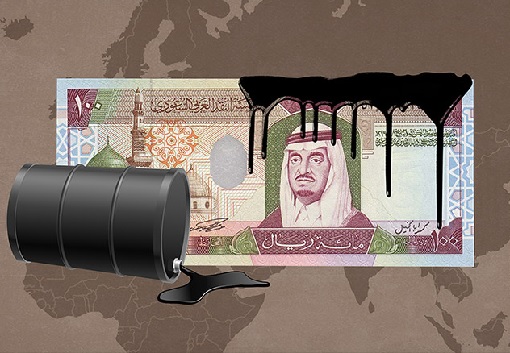Brent Crude Oil is trading just slightly above US$36 a barrel, forming a resistance-support at US$38-US$36 level. If today is somewhere June-2014, roughly one and a half year ago, and I were to tell you that global oil prices would tumble by 50% to US$60 a barrel; you would probably laugh to your death.
Likewise, if you are being told today that the oil prices would collapse further to US$20-US$25 a barrel; you would most likely laugh to your death, again. That would be absurd and doesn’t make any sense. How could the black gold lose any more than the 70% that it had already lost today? Ahh, but that was what you said when it plunged to US$60 from US$115.
More than 200-year ago in 1798, Thomas Robert Malthus famously predicted that the society would doom to poverty and misery – population would double every 20 years until people were no longer able to produce crops fast enough to feed themselves. The world population was merely 800 million in 1798 and has since grown to 6.7 billion today, something unimaginable by Malthus.
Malthus was wrong in his predictions because he failed to account for improvements in farming techniques, as well as the use of technology. Unlike other powerless animals, humankind will eventually find ways of producing. The average British field yielded just over 3- tons of cereal per hectare per year in 1961; today, it is twice that.
So, what has Malthus’ Principles of Population got to do with global oil prices? Just like food production technique, humankind will eventually find ways to innovate and improve oil consumption. It is just a matter of time before improved battery technology and ever-cheaper solar power finally lessen our dependence on the internal combustion engine and oil.
We will eventually be able to feed and fuel the world’s population using significantly less land and fewer hydrocarbons than we do today, even when the world reaches 9.2 billion by 2050. And just like the failure of Malthus crisis, there isn’t any shortage of global crude oil to begin with. But how could the price of Brent crude oil briefly reached US$147 a barrel in 2008?
Ahh, that’s the power of speculators or simply scammers, if you wish to call them. They create fear about supply shortage and BOOM! – investors rush to buy and hedge hence push up oil prices above its fair value. Likewise, they create fear about excessive oversupply and CRASH! – investors rush to dump their portfolio.
Isn’t it funny that the oil prices could collapse by 70% when global crude oil supply didn’t increase by 70%? Anyway, there’re many reasons for this historic oil price collapse. The old oil cartel – OPEC – has reached its tipping point as the kingpin who can influence oil prices. Thanks to innovative oil extraction through shale drilling, U.S. is becoming a net oil exporter.
At the same time, the slowdown in China has reduced demand for energy. Iranian’s promise to pump at least 500,000 barrels per day will further push down global oil prices. And if you think it will recover any time soon, stop dreaming. For the first time in its history, Saudi Arabia has posted the largest budget deficit – a whopping 367 billion riyals (US$97.8 billion; £66 billion; RM422 billion).
The usual arrogant Saudi government has no choice but promises to cut spending from 975 billion riyals to 840 billion riyals in 2016. Here’s the best part for the people of Saudi – price of gasoline will be raised by two-thirds (66%) to 0.75 riyals a litre from 0.45 riyals for 91 Octane fuel. The cut in subsidy will affect electricity, water and gas tariffs too.
Saudi needs the oil prices to be at least US$105 a barrel to balance its annual budget. However, by OPEC’s own admission about a week ago, the crude oil will recover to US$95 a barrel, but only in 24-years time by 2040. OPEC also predicted that a barrel of oil would cost around US$70 by 2020. This means Saudi will continue to suffer budget deficit for 24-years, even if their prediction is correct.
Clearly, OPEC’s prediction is overly optimistic considering they also predicted, in the same breath, that global oil demand would rise to 97.4 million barrels per day by 2020, a negligible rise of 500,000 barrels a day compared to last year’s outlook. By 2040, OPEC predicted overall demand to be close to 110 million barrels a day.
But why even bother about oil prices in 2040 when cars in the not so future will NOT be using traditional internal combustion engines at all? Honda’s chief technology strategy officer Keiji Ohtsu predicted that by 2025, Honda wouldn’t be selling conventional internal-combustion engines in China. Honda expects hybrids to account for 20% of global sales (and 80% sales in Japan) by 2020.
China is the world’s largest market for new cars, and it also has some of the world’s worst air pollution. Thus, Chinese emissions standards in place 10-years from now will be so strict that Honda will have an all-hybrid line-up there, likely augmented by some plug-in electric cars and hydrogen fuel-cell vehicles.
Toyota Motor has made its view loud and clear – hydrogen-powered cars are the future, although China has reportedly forced Toyota to build battery-electric cars. Like it or not, Toyota will roll out the Leahead and Ranz all-electric brands with its China partners Guangzhou Automobile Group and FAW Group early 2016.
Regardless whether it’s hydrogen-powered, battery-electric or hybrids, cars produced by 2020 will not use gasoline-only engines, let alone 2040. Gasoline-powered cars won’t be totally extinct but they would be insignificant. Malaysian-produced Proton is perhaps an example of car that might still be sucking petrol the conventional way, but even they’re toying with hybrid and electric cars.
Other Articles That May Interest You …
- Malaysians Refused To Give Way To VIP – A Sign Of People’s Uprising?
- Forget About US$30 Oil Price – It Could Hit US$20 Per Barrel Next Year
- TPPA – It’s A BAD Deal Unless It Benefits Working Class People
- Caught Speeding & Diplomatic Immunity Lie – Qatar Prince Flees U.S.
- Apple iOS-Liked Technology Coming To Your Car’s Windshield?
- Proton – The First Mahathir Legacy To Be Destroyed? Good Riddance
- Saudi’s Past Arrogance & Terrorists Funding – Is This Karma?
- Here’s How A $17 Gadget Breaks Your Car’s Keyless System
- This Country Is So Badly Hit By Oil Prices That Having Sex Is Impossible

|
|
January 1st, 2016 by financetwitter
|


|

|

|

|

|

|




































Comments
Add your comment now.
Leave a Reply